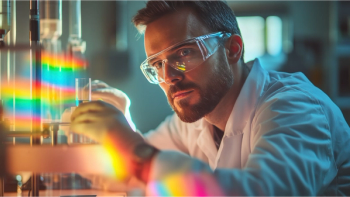Key Points
- A clinical trial at Maisonneuve-Rosemont Hospital demonstrated that the handheld UltraProbe Raman spectroscopy device can distinguish cancerous from healthy tissues during surgery for retroperitoneal soft tissue sarcomas (RSTS) with up to 94% accuracy.
- The UltraProbe outperformed earlier Raman systems by delivering a high signal-to-noise ratio, fast acquisition times, and minimal background interference, even in complex biological environments
- The study’s small sample size, inability to scan large tumor margins, and lack of positive margin analysis highlight the need for larger clinical trials and technological improvements to fully assess the device’s clinical utility in sarcoma surgery.
A recent study explored how a newly developed handheld Raman spectroscopy device, called the UltraProbe, can accurately detect retroperitoneal soft tissue sarcomas (RSTS) during surgery. This study, which was published in the journal Scientific Reports, showcases the growing trend of using portable spectroscopic instrumentation to improve surgical outcomes in patients with this rare and aggressive cancer (1).
What is retroperitoneal soft tissue sarcoma (RSTS)?
Retroperitoneal soft tissue sarcoma (RSTS) is a rare and heterogeneous group of malignancies that arise in the retroperitoneum, the part of the abdominal cavity behind the peritoneum. For RSTS, surgery is the normal way to treat it (2). Because of its location and lack of early symptoms, these tumors often grow large before detection and are challenging to treat (1). One of the most critical prognostic factors for RSTS is the complete surgical removal of the tumor with clean (negative) margins (1). However, current intraoperative methods like frozen section analysis are unreliable for sarcomas because of their complex histopathology.
What did the research entail?
In the study, the research team conducted a clinical trial at Maisonneuve-Rosemont Hospital in Montreal, Canada. This trial involved 30 patients undergoing surgical resection for RSTS (1). Using the UltraProbe system, the researchers collected the Raman spectra from the tumors during the operations. Then, using a machine learning (ML) algorithm called random forest, the team differentiated the cancerous tissues from the healthy ones (1). This method achieved 94% sensitivity and 95% specificity in distinguishing well-differentiated liposarcomas (WDLPS) from normal adipose tissue, with an overall accuracy of 94% (1).
What are the key takeaways from this study?
There are several key takeaways from this study and the results that were achieved. First, the researchers demonstrated here that portable Raman spectroscopy instruments can analyze tissue composition in real time. Second, the UltraProbe demonstrated improvement over previous Raman spectroscopy systems, which were noted for their longer acquisition times and low signal-to-background ratios (1). The device rapidly collects inelastic light scattering data with minimal background interference and delivers a high signal-to-noise ratio (SNR), even in biologically complex environments (1). Notably, the UltraProbe was able to operate with integration times short enough to provide real-time analysis, without interfering with the surgical workflow.
Another key takeaway is that the UltraProbe was able to achieve strong results for other sarcoma types. For example, when classifying both well-differentiated and dedifferentiated liposarcomas versus normal tissue, the system achieved 90% sensitivity, 93% specificity, and 90% accuracy (1). For non-liposarcoma soft tissue sarcomas, the UltraProbe maintained an accuracy of 87% (1).
What were the limitations of this study?
There were several limitations to this study. Because RSTS is rare, the data set was relatively small and included multiple subtypes of sarcoma, increasing the risk of overfitting the classification algorithm (1). However, the team employed cross-validation methods and chose an ML algorithm known for its robustness with small and imbalanced data sets (1).
Another key limitation was the UltraProbe. Its current design only allows it to sample a small area at a time. This limitation means it cannot assess the entire resection margin in large tumors, which a key factor when seeking complete tumor removal (1). Future advancements, such as wide-field Raman spectroscopy, may offer broader coverage, though current versions still require up to five minutes per square centimeter, restricting their real-time clinical use (1).
Positive margin detection was also not conducted in this study. All analyzed tissue sites were preselected based on macroscopic appearance, so further research is needed to validate the system’s effectiveness specifically for resection margins (1).
Additionally, the study briefly explored the effect of neoadjuvant radiotherapy on Raman signals. However, only five patients had undergone such treatment, and the sample size was too small to draw meaningful conclusions (1).
This study highlights the potential of the UltraProbe Raman system to provide non-destructive, real-time intraoperative tissue analysis in sarcoma surgery. If validated in larger trials, this technology could become a powerful adjunct tool, reducing the risk of incomplete tumor removal and improving outcomes for patients with RSTS, one of the most challenging cancers to treat surgically (1).
References
- Dulude, J.-P.; Le Moel, A.; Dallaire, F.; et al. Intraoperative Use of High-speed Raman Spectroscopy During Soft Tissue Sarcoma Resection. Sci. Rep. 2025, 15, 8789. DOI: 10.1038/s41598-025-93089-z
- De Bree, E.; Michelakis, D.; Heretis, I.; et al. Retroperitoneal Soft Tissue Sarcoma: Emerging Therapeutic Strategies. Cancers 2023, 15 (22), 5469. DOI: 10.3390/cancers15225469






